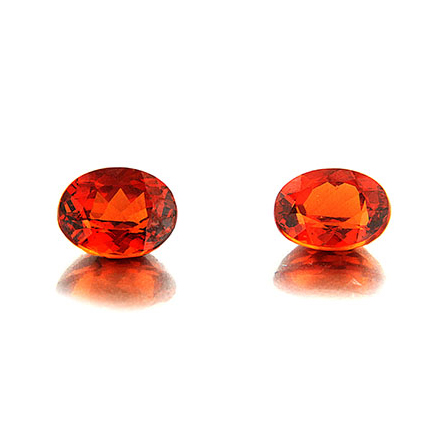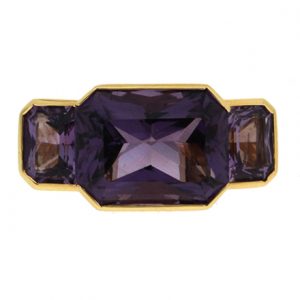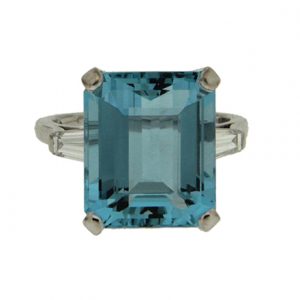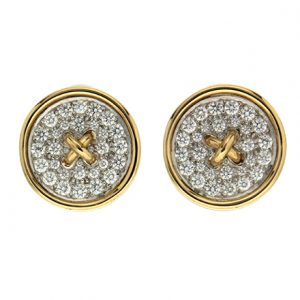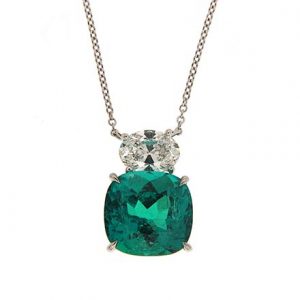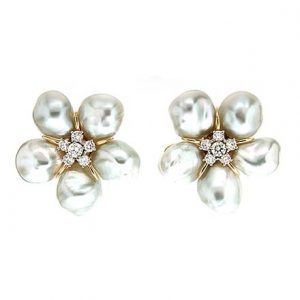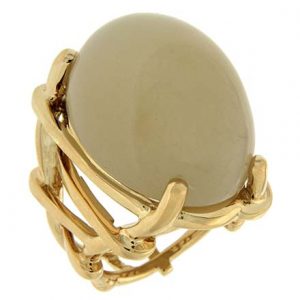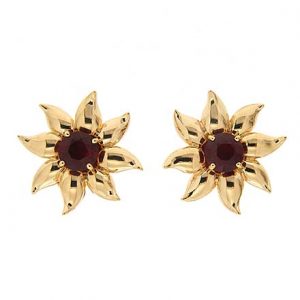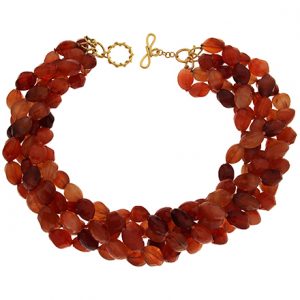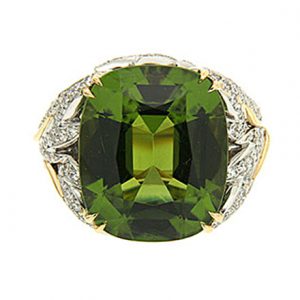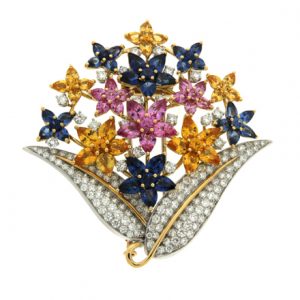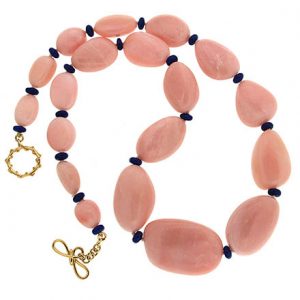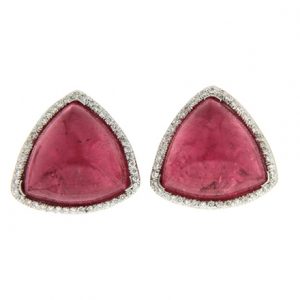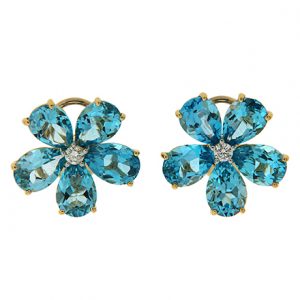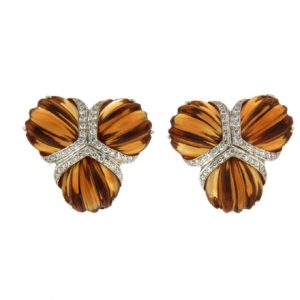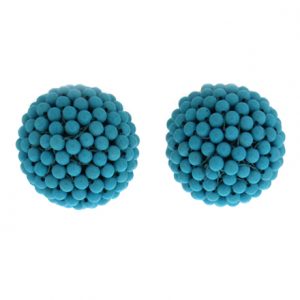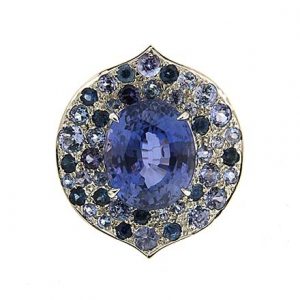The concept of birthstones trace back to the writings of Josephus and St. Jerome, who made references to a ceremonial garment known as the Breastplate of Aaron. According to them, the twelve stones on the breastplate were tied to the twelve months of the year, along with the twelve zodiac signs. From there, it was a small step to assigning a jewel to the date of one’s birth.
Due to quirks in classification, many regions and eras had their own ideas of what jewel represented which month. The first standardized list came out in 1912, penned by the American National Association of Jewelers, with later lists penned by different organizations.
Today, while different birthstones are associated with different traits, such as loyalty, most wearers attach other meanings to these jewels. Some may feel partial towards a stone for its association with the birthdate of a loved one or other special events associated with their personal lives. Read about the birthstones listed below, and see which ones speak to you.
January’s Birthstone
Garnet
Garnet’s most famous color is dark red. One possible origin for the jewel’s name is a variation on “pomegranate.” However this mineral family comes in a wealth of hues, including orange, green and clear, depending on the subtype. The elements that give garnets their rainbows are usually iron and calcium, though aluminum, magnesium and chromium influence a few garnet families.
The differences between garnets extend beyond what causes their coloring. Some garnet types are metamorphic, born under tremendous heat and pressure within the earth. Others are igneous, emerging from magma that has cooled enough to form beautiful stones. More visibly, some garnets contain eye catching inclusions which include stars, cat’s eyes and horsetails.
February’s Birthstone
Amethyst
The wine tinted birthstone of February derives its name from the ancient Greek words “a-” or not, and “methustos,” meaning “drunkenness.” Ancient Greeks believed that this jewel gained its color when the god Dionysius poured wine onto stone. Modern scientists believe that the gemstone gets it purple hues from iron impurities and naturally occurring radiation.
For centuries, amethysts were considered to be the peers of emeralds, sapphires and rubies. After the establishment of amethyst mines in Brazil, the stone became an affordable beauty. Today, a person can find amethyst anywhere, from casual adornments to crown jewels.
March’s Birthstone
Aquamarine
Like emeralds, March’s birthstone belongs to the beryl family of minerals. What distinguishes the aquamarine is the shade that inspired its name, derived from the Latin words for “sea” and “water.” With the help of iron mixed into its crystals, this jewel’s oceanic shades range goes from a light greenish blue to dark azure. The larger the stone, the more intense the hue.
In their rough state, aquamarines assume a six sided columnar shape. These crystals may be of a modest size, or be as large as 110 kilos. Its plentiful nature makes it easy to find stones that are flawless to the naked eye. Ideally, this jewel should be cut to intensify its coloring and ability to play with light. Popular cuts include the emerald cut, ovals and rounds.
April’s Birthstone
Diamond
April’s birthstone is the hardest substance on earth, the diamond. This popular stone is so tough that it can only be cut by other diamonds, and polished with diamond dust. Despite the adamantine nature of this jewel, its microscopic structure is quite simple, consisting of carbon arranged in a honeycomb pattern resembling an eight sided die.
This jewel is formed 75 to 120 miles below the earth’s surface, where great amounts of heat and pressure forces carbon into a distinctive crystalized shape. Other elements often find their way into the stones, giving most diamonds a hint of brown or yellow. On rare occasions, the shading is pronounced enough to give a diamond a “fancy” designation.
May’s Birthstone
Emerald
May’s birthstone is a vibrant member of the beryl family, the emerald. This jewel has many notable factors, including the unique patterns within each stone. Formally referred to as a “jardin,” these mossy features are frequently visible to the naked eye. Though they are technically imperfections, jardins are considered assets that add interest to an already beautiful stone.
Emeralds get their color from chromium, though not every chromium-infused beryl is considered an emerald. Only jewels with strong verdant hues are classified as May’s birthstone, with vivid saturation especially prized. The best colors are often found perpendicular to the top of an emerald rough. Cutters must be careful to shape the jewel in a way that brings out the best of its color while preserving its carat weight. Emeralds are so often cut into one form, a rectangle with parallel facets, that this shape is named in the stone’s honor.
June Birthstones
Pearl
June is rich in birthstones, with three that are officially recognized by the Gemological Institute of America, one of which the classic pearl. Before the advent and perfecting of pearl culturing techniques, this jewel was quite rare. People risked life and health to retrieve shell after shell. Out of ten thousand mollusks, perhaps one would possess a gem worthy of the name. Scarcity made pearls worth their weight in gold.
In the present day, pearls are widely available, born from many species. Four freshwater mussels from three different continents are capable of producing jewel quality pearls. Seawater producers include the admired Pinctada maxima and margaritifera species, which form the coveted South Sea and Tahitian varieties. Lesser known creators include Queen Conch and Abalone, which respectively create pearls with imbedded sparkle and distinctive sheen.
Moonstone
The ethereal birthstone of June is the moonstone. Moonstones are a blend of two minerals, the orthoclase and albite feldspar varieties. When the two sit on one another in thin alternating layers, light diffuses in an ethereal fashion, creating the phenomenon known as “adularescence.” Super thin layers make blue, while thicker layers make white. However, the body color comes from iron rather than light play.
Moonstones frequently feature long stress fractures with a series of small cracks running perpendicular along them. These quirks are known as “centipedes,” and are a welcome feature of the jewel, for their presence guarantees and authentic stone. Moonstones are also known to possess cat’s eyes and four pointed stars within their crystals. These jewels are often cut into cabochons to highlight the play of light inside, inclusions and all. Moonstones also have images carved upon them, such as children or the man on the moon.
Alexandrite
The multihued birthstone of June, alexandrite, is rarer than diamonds. A rare variant of chrysoberyl, this beryllium aluminate gains its distinctive features when chromium takes the place of a few aluminum atoms. This phenomenon only occurs when there is a lack of silica in the surrounding minerals; otherwise an emerald would form in place of an alexandrite.
Inclusions are rare in alexandrite, making visibly flawless stones easier to create. While clarity is a desirable feature in this gem, its color change qualities are so highly prized that a heavily included jewel with bright saturated colors is more valuable than a clear stone with muted shades. This jewel is trichroric, which allows for a different color to appear when viewed on three separate axis. Cutters must take care to orient this multihued trait to ensure it shows strongest through the top of the stone.
July Birthstones
Ruby
The more famous birthstone of July is the ruby. This red member of the corundum family gets its coloring from the element chromium is mixed into the crystal. Its hues can have pink, orange or purple undertones, though the most desired shade is called “pigeon’s blood.” This evocative name denotes a deep pure hue of red, with little to no secondary shades.
Rubies are found in both marble and basalt rocks. The jewels found in basalt tend to be darker, due to the iron content in the neighboring minerals. By contrast, rubies found within marble can become intensely red thanks to low iron surroundings. No matter a ruby’s origin, skilled cutters are able to enhance the crimson appearance in a jewel through careful placing and arrangement of facets.
Carnelian
The second birthstone of July, carnelian, is more of a hidden gem, so to speak. This member of the chalcedony family, like rubies, is best known for its red hues, though it’s also found in orange, brownish, and nearly black tones. Unlike other gemstones, which are colored due to trace elements, carnelian gets its shading from the compound iron oxide. This oxide can be unevenly distributed in the stone, resulting in a crystal with multiple colors.
Other features of this jewel include the way it plays with light, sometimes taking on an opaque form while other samples lean towards transparent or translucent. When polished, carnelian takes on a waxy sheen, further distinguishing it from the glitter of more popular jewels.
August Birthstones
Peridot
Peridot is August’s bright birthstone. A member of the olivine family, this gem ranges in tones from brownish or yellowish green to saturated green and verdant yellow. Though it’s a magnesium silicate, the iron in its chemical formula is what provides the stone’s pretty hues. Before the advances in jewel grading technology, some peridots were mistaken for topaz and even emerald.
This gemstone is exceptionally well-traveled. It has been found in the earth’s mantle, as well as lava flows and deposits in the United States, Antarctica, Vietnam, Finland and Ethiopia, among other places. The most exotic locations containing peridots are not of this earth, coming from comets and meteorites.
No matter where your peridot comes from, it is best cut in a way that highlights its color. Depending on the crystal, this can be emerald, round cushion or pear. The important factors to look for are uniform color and strong light.
Sardonyx
Sardonyx is the multicolored birthstone of August. Once believes to come from the fingers of Aphrodite, it is actually a red type of onyx and a member of the chalcedony family. Like black onyx, this jewel is found in deposits that formed from lava.
Not only is sardonyx favored for beads and cabochon stones, it has historically been a popular choice for carvings. The coloring of this stone comes in layers, which can lead to a relief image in which the foreground is crimson, the middle a rust tone, and the background vermillion. Those looking for a unique cameo to wear may wish to consider this unsung gem for their jewelry.
September’s Birthstone
Sapphire
September’s birthstone, sapphire, is a versatile member of the corundum family. It’s most associated with the color blue, with a medium saturation the most prized. Traces of titanium, iron and chromium are responsible with coloring this stone, with iron responsible for creating darker and azure shades. While cobalt tones are the most common, sapphires exist in every hue except red, which is when they’re considered rubies. One of the rarest and most desired of the “fancy” sapphires is a pinkish orange hue known as padparadscha.
While gemstones with tiny to nonexistent imperfections are usually preferred, one rare set of inclusions in sapphires is sought out and celebrated. The needle shaped mineral, titanium dioxide, appears in this jewel, the combination creates a cat’s eye or six pointed star within the gem.
Though star sapphires are cut in cabochons to display their asterism, most sapphires are cut into cushion or oval shapes, the better to intensify their coloring.
October Birthstones
Opal
October’s prismatic birthstone, opal, has many forms. Most versions display a fiery rainbow referred to as “play-of-color,” which changes depending on the angle from which it is viewed. No two opals show the same play. Jewel’s often cut these gems into cabochons to better showcase each stone’s unique brilliance.
Of the three major opal types, the translucent white opal displays its hues against a white to light grey background, while the opaque to translucent rare black opal uses a dark background for its prismatic displays. Transparent to translucent fire opals by contrast don’t always have a display of color, but have brightly colored bodies of yellow, orange, red or brown.
Despite the diverse nature of the stone, they all have the same origin. Opals are born when water blends with silica rich soil and sinks into fissure within the earth before evaporating. What remains are submicroscopic silica spheres stacked into formations resembling grids. When light enters the jewel, it bends around the grid, breaking into a rainbow’s worth of colors. The size of the spheres influence what colors emerge, with 0.1 micron sized silica producing violet and 0.2 microns creating red.
Tourmaline
The versatile birthstone for November, “tourmaline” is the name for a series of minerals that exhibits similar traits. Despite different chemical properties, are colorful, come from similar sources, and have rough in the form of cylinders. Tourmaline has also been mistaken for other jewels, including emeralds and rubies.
This stone is available in nearly every shade in the visible spectrum. Most specimens have two or more hues in the same crystal, which can lead to eye catching stones. Solid colored gems have often been confused for other gemstones, such as emeralds and rubies.
Tourmaline is found in rocks that have withstood intense heat and pressure, such as marble and granite. No matter what the chemical composition of a stone, tourmaline contains the elements silicon, boron, and aluminum. Blends of sodium, lithium, calcium and other elements distinguish one type of tourmaline form another and create the colors this stone is known for. From time to time, hollow tubes from within a crystal, creating a hazy cat’s eye effect.
November Birthstones
Topaz
This versatile gem is one of the two birthstones for November. This stone comes in many colors, ranging from completely clear, blue, red, pink, violet, brown, orange, yellow, and green. Sometimes topaz’s hues come from trace elements inside the crystal, while other times it’s tinted due to quirks in the atomic structure. The same gemstone can even take on different colors, depending on the angle from which it’s viewed.
Topaz crystals often form into long cylinders with pointed tips. This narrow shape makes cuts like oval or pear well suited to this stone. Another quirk of this gemstone is its size, with some crystals measured in kilos instead of carats. Designers and clients wishing for jewelry adorned with large gems will find that topaz makes a vibrant yet affordable choice.
Citrine
Citrine is another November birthstone. Its yellow, brown and red hues sometimes get it mistaken for a topaz, though in truth it is a member of the quartz family. This stone gets its tawny hues through by traces of iron tinting the quartz, or by subjecting an amethyst to low heat. The latter method is the most common source of citrine in the modern market. If you want to know if your beautiful jewel is natural or tinted with the aid of humans, don’t hesitate to ask.
Citrine is one of the most popular and frequently purchased yellow gemstones, helped by its availability in large sizes at affordable prices. Not only do jewelry aficionados take advantage of this gem’s prices, so do artists. Those seeking to experiment with avant-garde cutting techniques often do so with citrine.
December Birthstones
Turquoise
Like June, December has an abundance of birthstones. Turquoise has been around the longest, with the earliest examples dating from 5500 BCE. This jewel is found throughout the world in dry areas where the groundwater is acidic and rich in copper. The fluid reacts with aluminum and phosphate to create a gem that ranges in color from sky blue to the color of grass.
The softness of turquoise makes it suitable for carving. One such example sits in the Smithsonian Institute in the form of a snuff bottle with people and animals in relief. Cabochons and beads are also common forms of turquoise, often used in jewelry.
Since this stone is porous, precautions should be taken to keep turquoise pieces from discoloring. If the wearer wishes to apply perfume and cosmetics, it should be done before donning the jewelry. Turquoise should also be removed before bathing. These simple steps will help keep your stones as vivid as you wish.
Zircon
Not to be confused with cubic zircornia, zircon is a naturally found gemstone of a different chemical structure than the diamond simulant. Of the three December birthstones, zircon is the most colorful. This jewel comes in blue, green, yellow, and colorless shades, though the name “zircon” comes from the Persian word for “gold colored.”
One of the other notable features about zircon is its ability to double refract. As light enters the stone, it reflects off of the inner surfaces at an enthusiastic rate, revealing twice as many facets. To highlight this quirk, zircons are often cut in shapes that emphasize its brilliance.
Tanzanite
One of the members of the zoisite family, tanzanite is the purple-blue birthstone of December. Unlike the month’s other stones, zircon and turquoise, tanzanite has only been on the market a short time. It was discovered in 1967 in the Merelani hills of north Tanzania. By 1968, Tiffany and Company was manufacturing and marketing jewelry with this pretty new stone, named after its country of origin.
Tanzanite’s special features include its rarity. It is only found in the Merelani hills, in one of four mines. The stone’s atomic structure is also notable, as it allows it to change color depending on the light and what angle it’s viewed from. Your tanzanite may be blue, violet and burgundy all at once.





